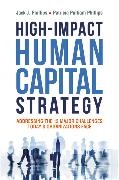Read more
Traditionally, human resources has focused on recruiting good people, preparing them for assignments, motivating them to perform, and retaining them. These functions remain essential, but to be successful in turbulent times like ours, human capital strategy needs to be broader and much more far-reaching.
High-Impact Human Capital Strategy examines 12 critical forces that must be considered: globalization, changes in workforce demographics, skill shortages and mismatches in labor markets, environmental matters, and more. It shows how to incorporate each into an effective overall plan, and how to translate that plan into action.You'll learn to design human capital programs that:
- Connect with business measures
- Achieve positive ROIEnsure critical talent is in place
- Boost engagement
- Address work/life balance and other social issues
- Reduce the need to outsource
Case studies and step-by-step guidelines help you move beyond hiring-training benefits functions, to develop human capital strategies that deliver measurablevalue in the face of ongoing challenges.
List of contents
Contents
Preface
Chapter 1The Importance of Human Capital: The Journey to Show the Value
Chapter 2The Importance of Human Capital Strategy and The Role of the CHRO
Chapter 3Force 1: Set the Appropriate Investment Level
Chapter 4Force 2: Align with Business Needs
Chapter 5Force 3: Managing Talent for Value
Chapter 6Force 4: Engage Your Employees at Work
Chapter 7Force 5: Create a Performance and Innovation Culture
Chapter 8Force 6: Keep Employees Healthy
Chapter 9Force 7: Embrace Demographics and Societal Changes
Chapter 10Force 8: Utilize Technology Effectively
Chapter 11Force 9: Confront Globalization
Chapter 12Force 10: Protect the Environment
Chapter 13Force 11: Build Global Leaders
Chapter 14Force 12: Use Analytics and Big Data
References
Index
About the author
JACK PHILLIPS, PH.D., is chairman of the ROI Institute. He is an active consultant, prolific speaker, and co-author of many HR books and articles.
PATRICIA PULLIAM PHILLIPS, PH.D., are chairman and president/CEO, respectively, of the ROI Institute. They are active consultants, prolific speakers, and co-authors of many HR books and articles.
Summary
Human Resources used to be about recruiting good people, preparing them for assignments, motivating them to perform, and retaining them. Do these things well and your well-oiled machine will operate as planned. But in today’s turbulent and increasingly broadening economy, HR must go beyond its traditional focus if a company is to also expand and become as far-reaching as the times are trying to take it. While the core plan of recruit, prepare, motivate, and retain is still essential, High-Impact Human Capital Strategy examines 12 critical forces that must also be evaluated and maximized if a company is to continue its success, including: globalization, changes in workforce demographics, skill shortages and mismatches in labor markets, environmental matters, and more. Readers will learn how to design human capital programs that:• Incorporate each of the 12 critical forces into an effective overall plan• Connect with business measures• Achieve positive ROI• Ensure critical talent is in place• Boost engagement• Address work/life balance and other social issues• Reduce the need to outsourceComplete with case studies and step-by-step guidelines to help you move beyond the traditional focus of Human Resources, the indispensable plans of attack found in High-Impact Human Capital deliver measurable value in the face of ongoing challenges that are not going away.

